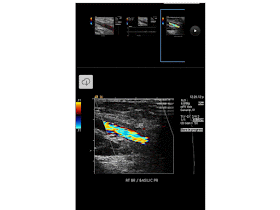Deep vein thrombosis
https://radiopaedia.org/articles/deep-vein-thrombosis
The term deep vein thrombosis (DVT) is practically a synonym for those that occur in the lower limbs. However, it can also be used for those that occur in the upper limbs and neck veins. Other types of venous thrombosis, such as intra-abdominal and intracranial, are discussed in separate articles.
The majority of deep venous thromboses occur in the lower extremities and begin in the soleal veins of the calf. Doppler compression sonography is the imaging modality of choice.
Features include:
Features include:
- non-compressible venous segment
- increased venous diameter: acute thrombus
- decreased venous diameter: chronic thrombus
- loss of phasic flow on Valsalva manoeuvre
- absent colour flow: if completely occlusive
- increased flow in superficial veins
- lack of flow augmentation with calf squeeze
- anechoic thrombus: acute thrombus
- echogenic thrombus: chronic thrombus
Key Points
© Springer International Publishing AG 2018
A. Creditt et al., Clinical Ultrasound,
https://doi.org/10.1007/978-3-319-68634-9_14
• Using point-of-care
ultrasound to evaluate patients in the
emergency department has been shown to decrease length of stay when compared with patients who
receive studies performed by the radiology department [4].
• Classically the
femoral vein lies medial to the femoral artery; however, a common anatomic
variant is for the femoral artery to travel anterior to the femoral
vein [1].
• Veins collapse
easily with pressure. If you cannot visualize a vein, apply less pressure with
the transducer.
• Apply direct and
even pressure over the vein to assess its compressibility:
– A false-positive
DVT can be diagnosed if uneven pressure is applied, therefore, resulting in an inability to completely compress the vein.
– This can also
occur with patients who have larger body habitus as it is harder to apply
direct and even pressure.
• Noncompressible
veins can also be seen with chronic DVTs:
– When a DVT
re-cannulates, it can cause the walls of the vein to become stiffer and less
responsive to compression.
• Do not rely on
visualization of the clot for diagnosis of a DVT as the appearance changes with
maturation:
– If a vein does not
completely compress, this is diagnostic of a DVT even if no thrombus is visualized within the lumen [2].
• While a chronic DVT
may appear more echogenic with thickened irregular walls, these findings may
not be present and it may not be possible to distinguish an acute from a
chronic thrombus [3].
• Point-of-care
ultrasound for DVT without the use of color Doppler can be less reliable in
patients with recurrent DVT:
– Approximately 50%
of ultrasounds can be abnormal 1 year after initial diagnosis of a DVT [5].



Không có nhận xét nào:
Đăng nhận xét